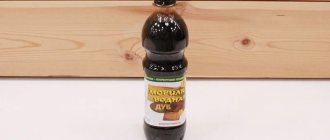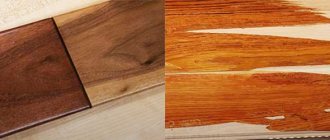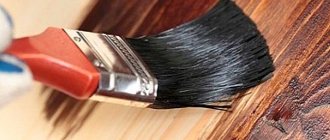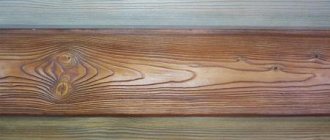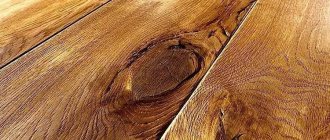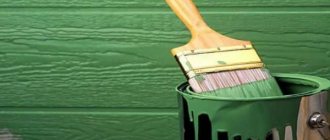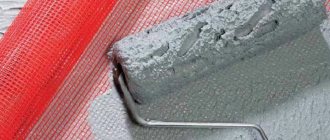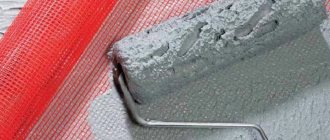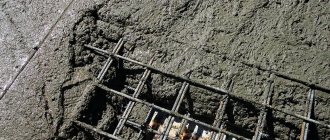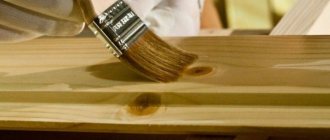Tree under the influence of negative factors Over time they lose their natural attractiveness and deteriorate performance characteristics: they fade under the influence of UV; deformed from excess moisture; rot when pathogenic microflora multiply.
To give a rich shade, preserve the structure, protect against destruction and extend service life , a special wood stain is used. Read more about what types of compositions there are, how to prepare them and what are the features of processing wooden surfaces.
What is stain used for?
Stain, or stain, is a special deep penetration composition that allows you to preserve the natural structure of the wood and give it the necessary shade . It can also be used to treat surfaces made of plywood, fiberboard, chipboard and MDF.
The main difference between stains and decorative enamels and paints is the deep penetration of tinting components , which allow you to color the wood from the inside, maintaining its texture and without forming a protective film on the surface.
You need to stain a tree to achieve the following goals:
- painting wood in a certain color or imitating expensive species;
- protection of wood from rotting and internal destruction due to the negative effects of moisture, infection with mold and pathogenic microorganisms;
- restoration and restoration of old and damaged wooden surfaces;
- giving wood a natural attractiveness;
- increasing strength and weather resistance;
- increasing the service life of the material;
- decoration by combining different shades.
When choosing impregnation, it is important to consider that not all compositions have the above characteristics.
Examples of interiors in wenge color
In the dining room and kitchen, it is better to use a classic scheme, according to which dark shades are given a place below head level. In this case, the room will seem more spacious. In addition, dark brown has a relaxing effect, which is not entirely appropriate in the kitchen, where the housewife needs a lively mood for preparing holiday dishes.
Wood tones are not necessarily present in furniture and flooring. Wenge can find a place for itself on the ceiling in the form of a tier of a multi-level ceiling. This solution is quite suitable for high walls. In this case, black wall cabinets are hidden, creating a niche effect, and do not compete with the nobility of the African guest.
What to do if you want dark brown walls? Maintain this shade in the chandelier, chandelier and tabletops. Decorate the walls and floor in creamy tones. Decorative accents of red, burgundy, and green are allowed.
Can wenge make friends with toffee? Yes, if you mix it with golden veins. A dark shade will emphasize the depth of the niche in the kitchen set. And so that he does not feel lonely, we will give him a door, a chandelier and lamps as companions. The chocolate napkins are the icing on this cake.
I really want tsavo, but the kitchen is small. And the hostess likes there to be a lot of light and space. What to do?
The solution is actually very simple. Order a white set with a horizontal contrasting stripe on the fronts of the wall cabinets. If you want even more contrast, use the same shade in the fronts of the lower cabinets. At the same time, white or steel narrow stripes will create movement dynamics. An excellent solution for modernity.
To relieve the feeling of hospital sterility, lay cocoa-and-milk colored tiles on the floor.
Wenge is a great place for creative ideas. At the same time, this color loves to be surrounded by milky and creamy tones interspersed with natural pink, purple, red and yellow shades. Create exquisite interiors that are characterized by luxurious simplicity and VIP class elegance.
Types and composition
Modern impregnating stains can be classified according to their composition . The following types are distinguished:
- aquatic;
- oil;
- alcohol;
- acrylic;
- waxy.
Water based
Such impregnations are produced in powder form (soluble in water) and ready-made liquid formulations. This is an environmentally friendly and safe product with an impressive range of shades.
Water stain does not have a pronounced odor, so it can be used to treat interior and exterior wooden surfaces. In addition, it is characterized by high elasticity and adhesion to wood .
Despite its safety and practicality, the composition has some disadvantages.
The main one is that it is not suitable for processing wood with a high resin content . This may cause dark spots to appear.
The next drawback is that when painting, wood fibers rise, which entails mandatory surface sanding . To eliminate this drawback, a non-aqueous wood stain is used.
Another disadvantage is a decrease in the moisture-resistant characteristics of wood with prolonged contact with moisture. They are quickly washed out by water, so they are not able to provide reliable protection of the material.
Oil based
Oil stains are based on coloring solutions in linseed oil or drying oil.
They are easy to apply with any available tool and have good resistance to fading, high humidity and temperature changes.
In addition, they do not lift wood fibers or fill them with excess moisture when stained .
Due to its high performance characteristics, this type of composition is suitable for treating structures inside and outside, forming a moisture-resistant protective film.
Thickened stain is diluted using white spirit.
Alcohol based
Impregnations are special solutions consisting of aniline dyes and denatured alcohol (alcohol base). They come in powder form and in the form of ready-made formulations.
Deep penetration of dyes into wood fibers leads to rapid coloring and drying of the surface .
To evenly stain wood with alcohol stain, it is recommended to use a spray gun . This will avoid the appearance of characteristic stains and stains.
Such compositions provide reliable protection of wood from negative atmospheric influences, and therefore have long been used to treat surfaces that are used outdoors .
Important! The main disadvantage of alcohol stains is the presence of a strong chemical odor.
Acrylic and wax based
Acrylic and wax impregnations are practically free of the disadvantages that are characteristic of traditional types . The compositions allow you to paint surfaces in any shade and increase their water-repellent properties.
The stains contain special acrylic resins and natural wax, which create a thin film to protect against the negative effects of external factors.
- Acrylic stains. They are environmentally friendly, fireproof and practical materials designed for various types of wood. They do not have a pronounced chemical odor, dry quickly, and have a wide color palette. To obtain a high staining result, it is better to apply the stain in two layers, the thickness of each of them should not exceed 3-4 mm.
- Wax stains. They are designed for treating painted wooden surfaces. Provide reliable protection from high moisture and temperature changes. The compositions are applied using a soft cloth in a circular rubbing motion.
Dealing with defects
It happens that the stain is applied to the surface incorrectly. Here are the main ways to eliminate defects:
- For numbness. Immediately after tinting the wood, you need to cover the area with varnish, which will dissolve the stain. Then clean the treated area with a rag. When the drip has already dried, it will have to be softened with white spirit or ground off with sandpaper.
- For stains. If we are talking about plywood, you will have to remove all the veneer using a plane. Solid wood is also processed with this tool, removing the thin top layer.
How can I remove stain?
The easiest way to remove water stain from your hands or treated wood. Of course, you can only remove the top layer, because such stains are distinguished by deep penetration. Stained clothes can be washed with regular powder, then rinsed with conditioner. If necessary, use oxygen bleaches, and chlorine bleaches on white items.
If stain gets on linoleum, wipe off the stain with acetone or white spirit. You must work carefully so as not to discolor the surface of the material. You can get rid of stain stains on the skin using vegetable oil or by frequently washing your hands with soap. It is much more difficult to remove non-aqueous types of stains from surfaces; you will have to remove the top layer of wood along with the tinting coating.
How long does it take to dry?
Each type of stain has different drying times , which are indicated on the packaging or in the instructions for the selected composition.
- When applied to a surface, water stains dry from 12 to 20 hours;
- alcohol compositions dry quickly, up to 5-7 minutes. In low temperature or high humidity conditions, drying time may be 30 minutes;
- oil impregnations dry in 1 to 2 days after application;
- acrylic compositions dry within 60 minutes;
- Wax stains dry for 12-14 hours after application.
Painting while preserving the structure
How to paint the lining to change the color but maintain a pronounced wood grain? You can use the brushing technique, which in this case involves processing the lining in several stages:
- First, pigmented oil, wax or glaze is applied to the surface.
- Then the selected varnish or paint for the lining is taken in a small amount, applied along the entire length of the board and gently shaded.
- After 10 minutes, use a soft, lint-free cloth to remove most of the oil.
The result of such manipulations will be a bright and expressive wood pattern, emphasized by the pigment remaining in the grooves and recesses. This method is great when using lining in different interiors: country, Provence and many others.
Color spectrum
In accordance with the international classification, each color is assigned its own code and name .
For example, “pine”, “walnut” or “fruit wood” stain.
To choose a wood stain in a suitable color scheme, you need to carry out a test painting of the wood and take into account:
- natural shade and type of wood subject to processing. Painting with stain can lead to the appearance of new shades;
- the color range stated in the catalogue. Colors under the same code from different manufacturers can produce shades of different depth and saturation on different types of wood. The same composition on pine will look lighter than on red wood. This can be explained by the fact that such wood has a more saturated natural shade;
- quality of stains. Compositions in the same color from different manufacturers can give different coloring effects. Therefore, you should not choose products of dubious quality;
- density of stains. The lower the density, the more the composition is absorbed into the wood. This results in a less saturated and deep shade.
The following colors of water-based wood stains are considered the most popular:
- “oak” – rich brown shade;
- “mahogany” – a noble burgundy shade;
- “pine” – the shade is close to the natural color of the wood;
- “natural” – natural light yellow shade;
- “light walnut” – practically does not change the natural color of the wood, and is used as a protective composition;
- “cherry” – light red and rich burgundy shade;
- “mahogany” – brown with light shades of red;
- “Wenge” – dark shades of brown;
- “larch” – from dark yellow to orange hue.
Peculiarities
The wenge tree itself has been growing for a hundred years or more; the dark, rich core is obtained from old trees. Young trees have lighter colors. It is impossible to find two trees of a given species that will have exactly the same shade; the color is influenced by various natural factors. For furniture production, dark colors with black veins are usually used; it is this option that gives the item nobility.
The wenge tree itself has been growing for a hundred years or more; the dark, rich core is obtained from old trees.
How to make it yourself
You can prepare a simple stain for wood processing at home:
- from plant ingredients;
- from tea and coffee products;
- from chemical components.
Based on plant materials
- Decoction of onion peels to obtain a bright red hue.
- A decoction of walnut peels to obtain a rich brown hue. To do this, the shell is crushed to a powder and boiled for 12 minutes in water. Add 1 tsp to the finished strained broth soda _ To obtain a red tint, potassium bichromate is added instead of soda; for a gray color, vinegar essence is added.
- Decoctions of oak, willow and alder bark give a rich black color.
- A decoction of buckthorn berries will paint the wood an attractive golden color.
From coffee, tea and vinegar essence
- To get a rich brown tint, it is enough to combine natural ground coffee and soda .
- To stain light wood, you can use a strong brew of black tea .
- To obtain a deep black shade, you need to place metal nails in a container and fill them with acetic acid . Leave for 5-7 days in a dark place.
Based on chemical components
- The brown tint is obtained after treating the wood with a solution of slaked lime .
- A deep cherry tint is achieved by applying a solution of potassium permanganate . To do this, you will need 60 g of potassium permanganate, which is diluted with a liter of heated water.
- A rich yellow tint is obtained by treating the surface with a decoction of barberry roots , to which alum is added.
- The herbal color will be obtained by combining 60 g of verdigris and vinegar essence . The mixture is boiled for 10 minutes.
- The dark brown color is obtained by combining wolfberry with copper sulfate . Glauber's salt with these berries gives a red color, and soda gives a blue tint.
With whitening effect
Bleaching stains are used as a base before painting wood, allowing you to achieve unusual color solutions . For example, apple wood can acquire a noble milky hue, and walnut can acquire a red or light pink color.
Whitening stains can be prepared as follows:
- Composition based on oxalic acid. To do this, 6 g of acid is diluted with 120 g of warm water. The finished stain is suitable for processing light or bleached wood. After application, the surface is thoroughly washed with the following solution: 4 g of soda and 16 g of lime are diluted in 110 g of water.
- Hydrogen peroxide based solution. To do this, you will need a 30% peroxide solution, which is available for sale at any pharmacy. It is suitable for bleaching various types of wood. However, it should not be used on oak, rosewood or mahogany.
Flow calculation
The main indicator that must be taken into account when calculating consumption is the degree of porosity of the base material. Any stain has excellent absorbency. On average, one liter of composition is required per 15 m2
It is also important to consider the intensity of the shade. Conifers have low absorbency, so they will need to be processed in several layers to achieve the desired pattern, which will at least double the consumption
The amount of material used is affected by the shape of the surface to be painted, the presence of corner locks, and hard-to-reach places. On each container of the mixture, manufacturers indicate how much mixture must be used to obtain a certain pattern. The exception is oil compositions, the task of which is to saturate the wood until the pores are completely filled. In this case, the type of tree and its condition are taken into account.
Useful tips
Let's look at some important tips:
- Do not apply the composition in the cold. Stain adheres very poorly to a wooden surface at low temperatures, so you will get uneven toning.
- If you are working with coniferous wood , then after removing the old paint/varnish you need to deresin the wood. Mix 100 g of acetone and 400 g of water, cover the surface of the wood with the mixture, rinse it off after 30 minutes and dry the wood.
- If you want to get a light cherry color of wood , then instead of stain you can use potassium permanganate for impregnation. Dissolve 50 g of potassium permanganate in 1 liter of water, saturate the wood with the mixture in 2 approaches.
In conclusion, I would like to note that when choosing a stain, you should not skimp. People usually buy cheap water-based compounds, but they need to remember that they are only suitable for finishing wood inside the house. If you want to tint outdoor wood structures or expensive items, be sure to buy acrylic, oil or wax stain. Let you pay an additional 600-700 rubles, but the effect of tinting will last for many years.
Wood stain video
